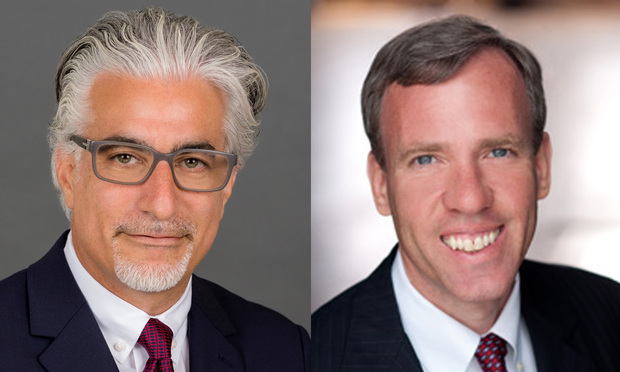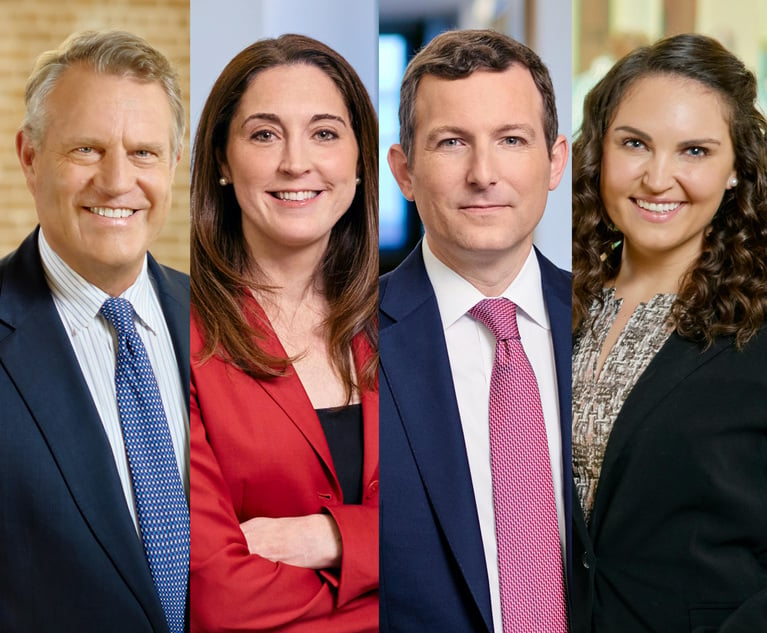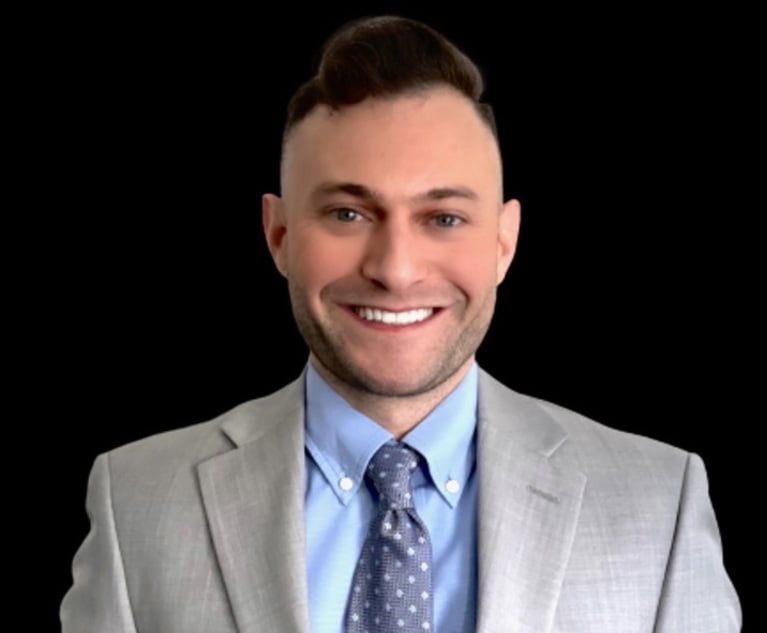March Sanity: Can Courts Finesse a Legal Remedy to NCAA's Fantasy of Amateurism?
After 10 years of antitrust litigation against the NCAA, including two bench trials, Judge Claudia Wilken has twice found that the NCAA is unlawfully conspiring to suppress compensation of student-athletes who play at the highest level of college football and men's and women's basketball.
March 28, 2019 at 03:06 PM
11 minute read
 (L to R) Paul Berks, and founding partner Jonathan Massey, Massey & Gail (Photo: Courtesy photo)
(L to R) Paul Berks, and founding partner Jonathan Massey, Massey & Gail (Photo: Courtesy photo)
After 10 years of antitrust litigation against the NCAA, including two bench trials, Judge Claudia Wilken has twice found that the NCAA is unlawfully conspiring to suppress compensation of student-athletes who play at the highest level of college football and men's and women's basketball. (Findings of Fact and Conclusions of Law, ECF No. 1162, (March 8, 2019), In re National Collegiate Athletic Association Athletic Grant-in-Aid Cap Antitrust Litigation, 14-md-02541 CW (N.D. Cal.))
Wilken's most recent decision, the March 8 Findings of Fact and Conclusions of Law, thoroughly takes down the NCAA's unlawful conduct, rejecting the NCAA's testimonials to “amateurism” as hollow, self-serving, unsupported by the evidence, and disconnected from reality. In fact, as page after page takes the NCAA to task for the foolishness and inconsistency of its arguments, something like anticipation starts to take hold.
Is this an historic decision?
Can the weight of evidence and logic destroy the most storied of American cartels?
Not this time. The NCAA is on the ropes, but it is not out. It wobbles, but it stands.
Wilken's relentless battering of “amateurism” means the NCAA's empire rests on increasingly unstable foundations. The decision implicitly asks how long the NCAA's conduct can last without a viable legal rationale. The Ninth Circuit will soon get a chance to consider that question; other courts should be given the opportunity as well with the full benefit of Wilken's comprehensive fact-finding.
Though this chapter of the NCAA saga ends with a whimper, not a roar, there are likely more chapters to be written; more battles to be fought. The territory taken from the NCAA on March 8, will loom large.
- “Amateurism 'is just a concept. I don't even know what it means. I really don't.'”
At trial of the case known as Alston after a lead plaintiff, the NCAA relied principally on the purported pro-competitive effects of “amateurism” to justify its conduct. Wilken does not think much of “amateurism.” She is eye-rolling, head-shakingly dismayed by the NCAA's effort to paint its massive economic windfall—the understated reference to the $19.6 billion for March Madness broadcast rights says it all on that score—as a collateral consequence of its noble role of protecting “amateur” athletes from “exploitation by professional and commercial enterprises.”
The NCAA argued that amateurism justifies not paying student athletes and, in support, defined amateurism as “not paying the participants.” But it cannot even support its own syllogistic definition because the NCAA offers and permits many forms of what a layman would call “pay,” while declaring by fiat that athletes can receive such payments and still be amateurs. “A review of the bylaws shows that many forms of payment, often in unrestricted cash, from schools and other sources, are allowed by the NCAA as 'not pay,' and thus not inconsistent with amateurism.”
Wilken enumerates the many examples of “amateurs” receiving various forms of “not pay,” including visa gift cards, iPad minis, speakers, watches and cash payments from two NCAA-created slush funds. These payments do not alter the recipient athletes' status as an amateur for NCAA purposes solely “because the NCAA has chosen to permit them.”
Ultimately, it is hard to dispute Wilken's conclusion that “the only thing that can be inferred is that compensation constitutes 'pay for play' or 'pay' if the NCAA has decided to forbid it, and compensation is not 'pay for play' or 'pay' if the NCAA has decided to permit it.” The NCAA's “principles of amateurism” cannot be taken seriously because they are “circular,” “arbitrary,” and lacking any “cogent explanation.” The court leaves it to a witness, Mike Silve, a former commissioner of the Southeastern Conference, to deliver the coup de grace. Amateurism, he says, is “just a concept that … I don't even know what it means. I really don't.”
In the end, the “concept of amateurism,” at least as the NCAA wields it, is wholly fanciful. In the wake of Wilken's decision, the foundations of the NCAA's empire are in shambles.
- “Revenues are one of the best economic measures of consumer demand.”
The court's take-down of “principles of amateurism” is fun reading, but why does it matter? Because the NCAA's pro-competitive justification for its monopsony price fixing is that college sports fans really love amateurism. The NCAA has to give its fans what they want, and they want to see amateurs—not professionals—dunking basketballs and catching touchdowns for their respective alma maters. Without the fans, there is no college athletics, and without “amateur” athletes, there are no fans, according to the NCAA.
The problem with this theory, as Wilken explains, is that there is no evidence to support it.
- The opinions of the NCAA's “only economics expert on the issue of consumer demand” are “unreliable” because he “failed to study the effect of changes to student athlete compensation on consumer demand,” which is the very subject about which he was called to testify.
- The NCAA survey on consumer demand was so poorly drafted that the “responses [were] hopelessly ambiguous,” and, in any event, most respondents did not identify amateurism as a factor in their appreciation for college sports.
- There was “no evidence that NCAA bylaws limiting compensation are enacted based on any analysis of consumer demand.”
Not only is there no evidence to support the fans-love-amateurs rationalization, there is plenty of evidence to refute it. The “only economic analysis in the record that specifically speaks to the effects of [increased] compensation amounts on consumer demand” noted that compensation went up in 2015 (as a result of the first trial over which Wilken presided) and revenues did too. As the court drolly puts it: “Revenues are one of the best economic measures of consumer demand.” If revenues and compensation move in tandem, consumer demand is not negatively correlated to compensation. According to the court, even the NCAA's witnesses conceded this. Thus, even if it the “concept of amateurism” could be pinned down to an articulable principle, it would not justify the NCAA's compensation-suppressing activity because there is no evidence to support a link between the two. The evidence to the contrary is tsunamic.
- The “Quantum Leap”
So, amateurism doesn't exist and, even if it did, consumers are perfectly willing to spend their money on NCAA Division 1 sports regardless of whether the athletes are amateurs. We are now well into the court's decision, and it does not look good for the NCAA.
The only break from the methodical hammering of the NCAA's position is when the court concludes “that some of the challenged compensation limits may have some effect in preserving consumer demand to the extent that they serve to support the distinction between college sports and professional sports.” (Id. at 45.) That hardly seems enough to rationalize “the extraordinary revenue” the NCAA collects as compared to the “modest benefits” athletes receive.
So the reader is forgiven for not having noticed that the arc of the story has subtly changed. For this story, it turns out, has a twist. It is like a mystery novel with a character who seemed incidental, or even likable, at the outset, but turned out to be the killer. In this story, that role is played by the 2015 decision of the U.S. Court of Appeals for the Ninth Circuit in O'Bannon v. NCAA, 802 F.3d 1049 (9th Cir. 2015)).
O'Bannon was the path-breaking case that put the first chink in the NCAA's armor. For the most part, the Ninth Circuit affirmed Wilken's decision in O'Bannon, which is reflected in the many citations to O'Bannon throughout Wilken's more recent opus. Indeed, for well over 80 pages, O'Bannon is a comforting presence; a reminder that the issues litigated in Alston were previously aired and the NCAA's feeble justifications were rejected before.
But the appellate court's 2015 O'Bannon decision has a dark side, too. The Ninth Circuit also reversed in part the remedy Wilken fashioned for the O'Bannon plaintiffs, which was a limited escrow account for Football Bowl Subdivision players and Division 1 men's basketball players payable after they left college. Trial courts generally have wide discretion to structure a remedy that properly fits the violation. The O'Bannon remedy of limited and delayed payments seemed well within this traditional equitable discretion.
Yet two of the panel's three members considered such payments improper because they were “untethered to their education expenses” and therefore inconsistent with amateurism. The appellate court explained its reasoning in the following terms: “The difference between offering student-athletes education-related compensation and offering them cash sums untethered to educational expenses is not minor; it is a quantum leap. Once that line is crossed, we see no basis for returning to a rule of amateurism and no defined stopping point.” Chief Judge Sidney Thomas, writing in dissent on this point, gave a prescient response. “To the contrary, the district court concluded after a full bench trial that the distinction between offering student-athletes no compensation and offering them a small amount of compensation is so minor that it most likely will not impact consumer demand in any meaningful way.” (Thomas J., concurring in part and dissenting in part)).
Tethering
Wilken seems to have interpreted the O'Bannon majority's “tethering” statement broadly. Regardless of the findings of fact—that is, no matter what the facts might show—she concluded that the remedy should not allow for payments “untethered to … educational expenses.” (March 8, 2019, Findings of Fact and Conclusions of Law at 94.)
She had once before concluded that small payments would not impact consumer demand and been rebuffed. Thus, there is a fundamental contradiction at the heart of Wilken's decision.
On one hand, based on the evidence presented at the Alston trial, the court concluded “that payments above the cost of attendance do not vitiate student-athletes' NCAA amateur status, even when such payments are made in cash-equivalents, are unrelated to education, and can amount to thousands and even tens of thousands of dollars.”
The remedy, however, allows the “NCAA [to] continue to limit compensation and benefits, paid in addition to the cost of attendance, that are unrelated to education.” This is the long shadow of “tethering.” The NCAA must remove “caps on education-related benefits only,” such as “computers, science equipment, musical instruments,” and other education-related expenses, which the NCAA “in an exercise of discretion and good faith” may establish.
To be clear: the court concluded that the NCAA exercises monopsony power and conspires to suppress compensation. It makes billions from “amateur” athletics every year and shares only a pittance with the athletes whose talent and effort are at the heart of college sports. There is neither an evidentiary nor a logical justification for this discrepancy. And the remedy? The NCAA can no longer restrict schools from paying for science books and musical instruments.
Huh?
This is as absurd as it sounds. The remedy does not follow from the findings. Wilken's application of the law is inconsistent with her own understanding of the facts. The Ninth Circuit's “tethering” holding may explain this result. But the detailed findings of fact from two trials show that the Ninth Circuit's holding cannot reasonably be construed so broadly.
Regardless of whether Wilken properly applied the O'Bannon decision, “tethering” got only two votes back in 2015. Thus, including Wilken with the dissenter, the judicial score is just 2-2 on how to remedy the NCAA's unlawful conduct. As Wilken's findings of fact and conclusions of law make their way back to the Ninth Circuit, both the scope of “tethering” and its stare decisis value will face off against Wilken's thorough and painstaking fact-finding. With the NCAA filing a notice of appeal on March 22, and the plaintiffs expected to file their own appeal, the future of the NCAA's price-fixing may well depend on how the Ninth Circuit resolves this conflict.
Jonathan S. Massey is a founding partner at Massey & Gail.
Paul Berks, a former law clerk to Judge Claudia Wilken, is a partner at the firm. Massey & Gail represented the plaintiffs on appeal in the O'Bannon case.
This content has been archived. It is available through our partners, LexisNexis® and Bloomberg Law.
To view this content, please continue to their sites.
Not a Lexis Subscriber?
Subscribe Now
Not a Bloomberg Law Subscriber?
Subscribe Now
NOT FOR REPRINT
© 2025 ALM Global, LLC, All Rights Reserved. Request academic re-use from www.copyright.com. All other uses, submit a request to [email protected]. For more information visit Asset & Logo Licensing.
You Might Like
View All
'Another Broken Promise': California Tribes Sue Casinos for Allegedly Illegal Profit From Card Games

Just Ahead of Oral Argument, Fubo Settles Antitrust Case with Disney, Fox, Warner Bros.

Lawsuit alleges Fox Sports ex-host harassed hairstylist and offered her $1.5M for sex
3 minute read
'Pull Back the Curtain': Ex-NFL Players Seek Discovery in Lawsuit Over League's Disability Plan
Trending Stories
- 1Many LA County Law Firms Remain Open, Mobilize to Support Affected Employees Amid Historic Firestorm
- 2Stevens & Lee Names New Delaware Shareholder
- 3U.S. Supreme Court Denies Trump Effort to Halt Sentencing
- 4From CLO to President: Kevin Boon Takes the Helm at Mysten Labs
- 5How Law Schools Fared on California's July 2024 Bar Exam
Who Got The Work
Michael G. Bongiorno, Andrew Scott Dulberg and Elizabeth E. Driscoll from Wilmer Cutler Pickering Hale and Dorr have stepped in to represent Symbotic Inc., an A.I.-enabled technology platform that focuses on increasing supply chain efficiency, and other defendants in a pending shareholder derivative lawsuit. The case, filed Oct. 2 in Massachusetts District Court by the Brown Law Firm on behalf of Stephen Austen, accuses certain officers and directors of misleading investors in regard to Symbotic's potential for margin growth by failing to disclose that the company was not equipped to timely deploy its systems or manage expenses through project delays. The case, assigned to U.S. District Judge Nathaniel M. Gorton, is 1:24-cv-12522, Austen v. Cohen et al.
Who Got The Work
Edmund Polubinski and Marie Killmond of Davis Polk & Wardwell have entered appearances for data platform software development company MongoDB and other defendants in a pending shareholder derivative lawsuit. The action, filed Oct. 7 in New York Southern District Court by the Brown Law Firm, accuses the company's directors and/or officers of falsely expressing confidence in the company’s restructuring of its sales incentive plan and downplaying the severity of decreases in its upfront commitments. The case is 1:24-cv-07594, Roy v. Ittycheria et al.
Who Got The Work
Amy O. Bruchs and Kurt F. Ellison of Michael Best & Friedrich have entered appearances for Epic Systems Corp. in a pending employment discrimination lawsuit. The suit was filed Sept. 7 in Wisconsin Western District Court by Levine Eisberner LLC and Siri & Glimstad on behalf of a project manager who claims that he was wrongfully terminated after applying for a religious exemption to the defendant's COVID-19 vaccine mandate. The case, assigned to U.S. Magistrate Judge Anita Marie Boor, is 3:24-cv-00630, Secker, Nathan v. Epic Systems Corporation.
Who Got The Work
David X. Sullivan, Thomas J. Finn and Gregory A. Hall from McCarter & English have entered appearances for Sunrun Installation Services in a pending civil rights lawsuit. The complaint was filed Sept. 4 in Connecticut District Court by attorney Robert M. Berke on behalf of former employee George Edward Steins, who was arrested and charged with employing an unregistered home improvement salesperson. The complaint alleges that had Sunrun informed the Connecticut Department of Consumer Protection that the plaintiff's employment had ended in 2017 and that he no longer held Sunrun's home improvement contractor license, he would not have been hit with charges, which were dismissed in May 2024. The case, assigned to U.S. District Judge Jeffrey A. Meyer, is 3:24-cv-01423, Steins v. Sunrun, Inc. et al.
Who Got The Work
Greenberg Traurig shareholder Joshua L. Raskin has entered an appearance for boohoo.com UK Ltd. in a pending patent infringement lawsuit. The suit, filed Sept. 3 in Texas Eastern District Court by Rozier Hardt McDonough on behalf of Alto Dynamics, asserts five patents related to an online shopping platform. The case, assigned to U.S. District Judge Rodney Gilstrap, is 2:24-cv-00719, Alto Dynamics, LLC v. boohoo.com UK Limited.
Featured Firms
Law Offices of Gary Martin Hays & Associates, P.C.
(470) 294-1674
Law Offices of Mark E. Salomone
(857) 444-6468
Smith & Hassler
(713) 739-1250






